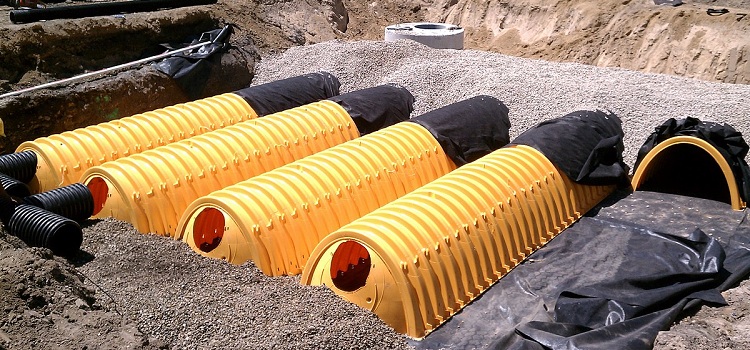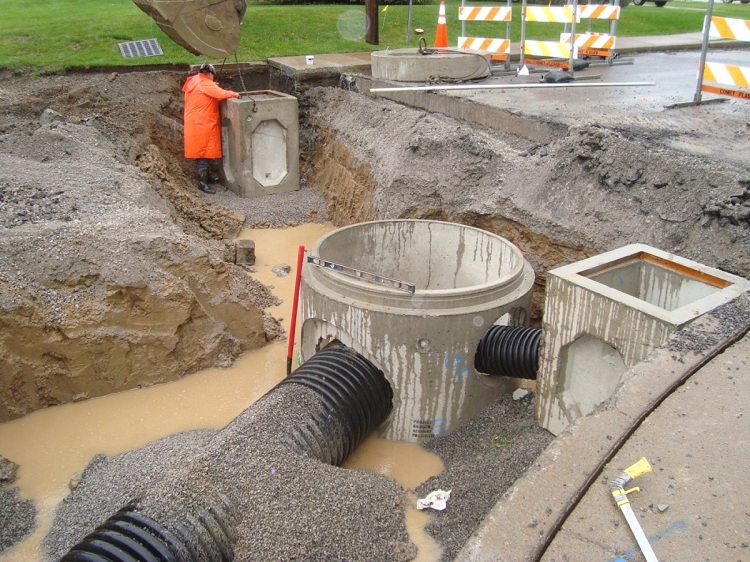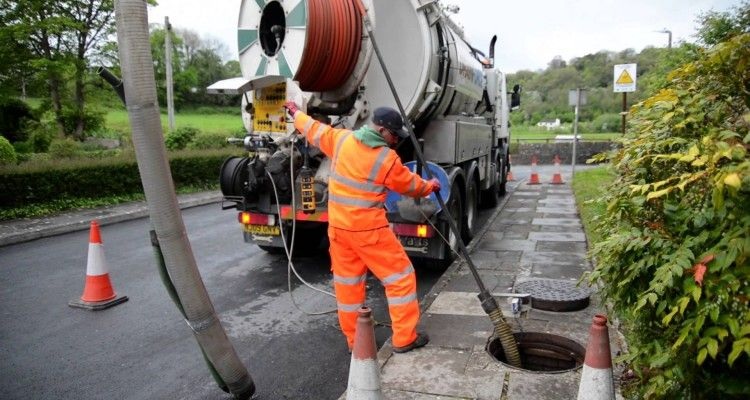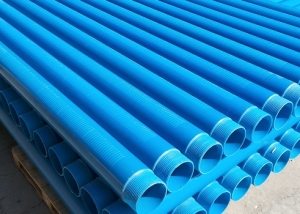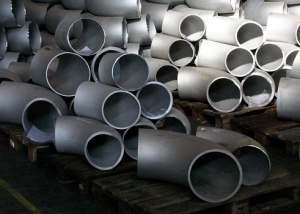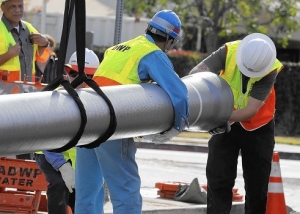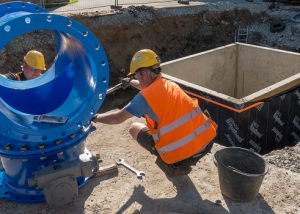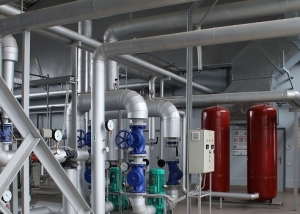The storm sewer system is one of the engineering networks designed for quick drainage of precipitation. The construction of storm sewer structures is considered necessary in cases where it is necessary to provide protection against flooding of certain areas, to protect the foundation and walls of buildings from destruction, to lower the humidity level to ensure a comfortable stay for people or normal functioning of the equipment.
Content
How can storm water construction be carried out?
According to the method of collecting precipitation, the laying of storm sewers can be carried out:
- linear. Water is collected and transported through a network of canals. The standards governing the design and construction of a linear system are set out in SNiP 2.04.03-85. In particular, installation is provided with a slope directed towards the main manifold. In the presence of conditions that do not allow for the movement of moisture by gravity, since the minimum slope is not maintained, it is necessary to resort to the installation of transfer pumps. When laying a closed storm sewage system, consisting of several storm water inlets that are connected by pipes laid at a depth that divert rainwater into the collector, SNiP provides for the installation of inspection wells of a meter diameter that allow you to control the operation of the system and carry out actions for its maintenance;
- pitted. The system consists of storm water inlets connected by pipes.
Note! The rules set out in the technical conditions oblige to ensure the safety and long-term functioning of the point storm shower system to install protective gratings on the storm water inlets and to mount special sand filters.
Based on the method of collecting and discharging precipitation, the storm sewer system can be attributed to:
- aryky. The structures of the aryky (open) storm sewer are open channels connecting the drainage trays. Industrial design looks like a set of concrete trays, covered with metal gratings. The advantage of the irrigation system, openly communicating with the environment, is the simplicity of construction at low cost for materials and attracted resources. In addition, it is adapted for irrigation needs.;
- closed. Plumbing is hidden. The system is provided by storm water inlets - special intermediate storage tanks. The diverted products are delivered, as usual, to treatment facilities, from where they are transferred to reservoirs of natural or artificial origin;
- mixed. To implement such an option for the removal of precipitation, resorted to due to the characteristics of individual sections of the terrain and in order to save material and financial resources.
How storm sewers are calculated and a project is prepared in accordance with SNiP
The calculation of storm sewers is carried out in accordance with SNiP 2.04.03-85, which regulates the construction of external networks and sewage structures. When storm sewers are being built with their own hands, then in order to draw up a project, in principle, it is enough to calculate only four main indicators using a calculator:
The volume of water discharged to calculate the required system performance.
- Pipe diameter.
- Bias.
- Depths of pipes in the ground.
The flow volume is calculated according to the formula
Q = q20 × F × Ψ, in which:
Q is the calculated volume; q20 is a coefficient related to the intensity of precipitation. The intensity of precipitation is measured in liters in seconds per hectare of area. The coefficient value for a particular area can be obtained either by contacting the local weather service or environmental architectural service, or determined by a graphical diagram from SNiP; F - the area designated in hectares from which water will be discharged. When dealing with a pitched roof, the area is determined using the horizontal projection; Ψ - the value of the correction factor, taking into account the ability of a certain type of coating to absorb moisture.
It is accepted:
- for the roof of the building for 1.0;
- for asphalt pavement - 0.95;
- concrete - 0.85;
- rammed crushed stone - 0.4;
- open ground, sod soil, lawns - 0.35.

The diameter of the pipes for storm sewers is selected depending on the volume of effluents that will move along it
Calculation is mandatory for each section with a storm water inlet to determine the minimum diameter of the pipe for water disposal. If there are several storm water inlets on the water supply section, then the flow volume is summed up. Determining the required diameter for the collector pipe, consider the amount of runoff from the entire equiped area.
Helpful information! In practice, pipes with a diameter of 110-150 mm are taken for water disposal and 200 mm for a collector.
The slope per linear meter is taken in mm for pipes with a diameter of:
- 50 mm - up to 30;
- 110 mm - 20;
- 150 mm - up to 10;
- 200 mm - 7.
It is advisable to lay so that the slope is greatest when tapping into the storm water inlet to speed up the flow. Before sand traps, it is advisable to lower the flow rate to suspended particles, so the slope can be reduced.
The depth of storm sewers is determined based on local experience in the construction of sewer network facilities. As a general rule, from the surface of the soil to the pipe should be at least 700 mm. At a shorter distance, it is mandatory to provide protection against damage caused by external mechanical loads and thermal insulation.
Provide for inspection wells where:
- the diameter, direction or level of the pipeline;
- the pipe joins;
- the distance in the straight section between them reaches 35 m (with a pipe diameter of 150 mm). With large diameter values, the distance increases to 50 m (diameter - from 200 mm) and 75 m (diameter from 500 mm).
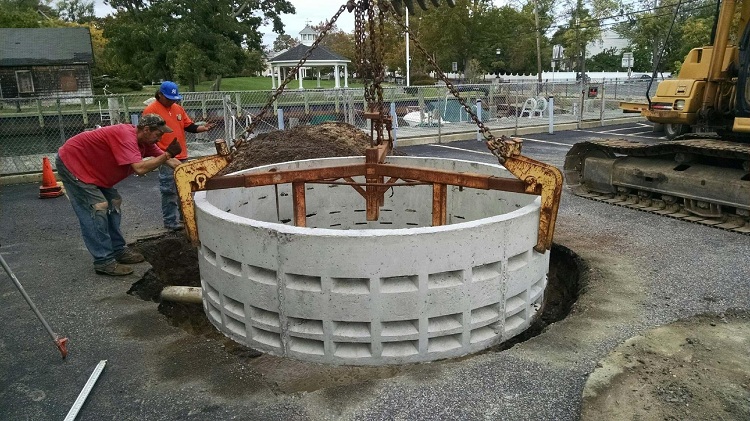
The depth and size of the well also matter and these parameters are calculated depending on the diameter of the pipes, which are reduced inside the collector
For wells with a depth of more than three meters, a minimum diameter of 1,500 mm is provided, a diameter of 700 mm is permissible for wells with a depth of up to 1,200 mm for pipes with a diameter of up to 150 mm.
Installation of storm sewer
The outer part of the system begins to be installed by connecting to the gutters of buildings. To do this, produce:
- installation of storm water inlets fixed with bituminous mastic and waterproofing;
- the installation of trays or pipes, depending on which precipitation collection system, point or linear, it was decided to choose;
- installation of drainpipes (risers);
- organization of a spillway, open - in a tray or closed - in a collector.
External storm sewers are in the following order:
- Mark up using a tracing cable.
- The external part of the system requires excavation, during which trenches and wells are laid, as well as ditches for the installation of ground trays.
- Ground storm water inlets are installed.
- Having fallen asleep and rammed sand at the bottom of the trenches, pipes and trays are laid in the designated places.
- All elements of storm sewers, including storm water inlets, sand traps and wells, are combined into a single system.
- After fixing the trays on the cement mortar and installing metal grates, the inside of the system is filled up.
- After a trial pouring, you can proceed to the operation of the installed system.
Storm sewer service
Repair of storm sewers, in principle, is not implied, since a properly designed system has the property of self-cleaning. Of course, it is impossible to avoid clogging, since suspended particles are contained in the water, which, settling, gradually silt the system, leading to a gradual decrease in its throughput.
Important! A control inspection and preventive cleaning of storm sewers are recommended annually. In practice, cleaning is done seasonally: in spring - after snow melts, in autumn - on the eve of long rains.
When carrying out on the construction site and significant repair work, cleaning is also desirable.
On a suburban area it is applied:
- mechanical cleaning of individual elements of the system with punching, if necessary, of formed traffic jams;
- flushing of storm sewers by the hydrodynamic method, under strong pressure of water.
At industrial facilities where fat or organic elements may enter drains, they also use:
- washing with steam or boiling water (hot water), i.e., thermal exposure;
- special chemicals for dissolving blockages.
Self-repair of storm sewage irrigation (open) type is not particularly difficult. It is carried out in two stages:
- Raising the grates, remove the debris and dirt accumulated in the gutters, clean the sand traps.
- After washing the system elements with a water jet, previously removed back are installed.
Work in the underground parts of the system is more difficult to do. You will need to start at the top. The sequence is as follows:
- storm water inlets are processed;
- pipes are cleaned, sometimes with the use of a plumbing cable;
- flushing is carried out on both sides, starting with the reception.
Well cleaning involves:
- the release of cavities from silt and sand deposits;
- drainage and purification of oil and gas separator from dirt (if any);
- removing, rinsing with water and re-installing (or replacing) sponge filters or coalescent modules.
After carrying out cleaning work and necessary repairs, the stormwater is again fully operational.
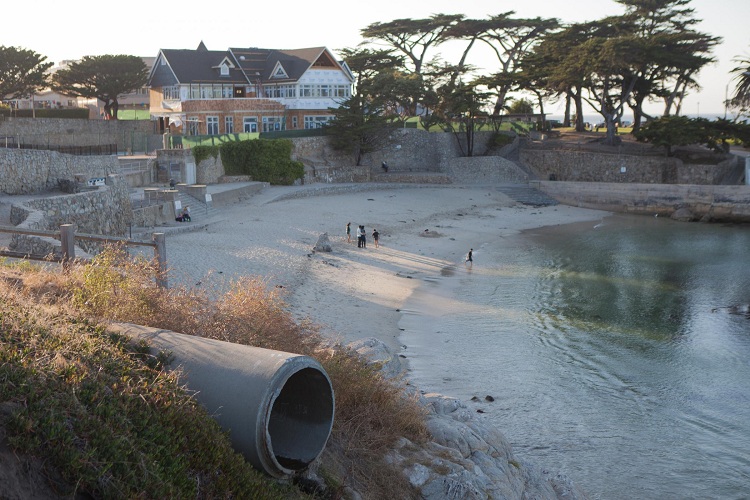
Effluents from storm sewers are most often discharged into the nearest body of water of natural or artificial origin.
Compliance with the protection zone and the collection of collected water
When arranging the sewage system, including storm water, SNiP provides for the organization of a security zone within five meters of pipes. In the security zone it is prohibited:
- block freedom of access to the inspection well;
- plant trees and shrubs at a distance of less than three meters from the pipes;
- to erect structures even of a temporary nature;
- equip parking;
- to landfill.
In connection with such requirements, the task of diverting the water collected at the site can be complicated, especially in the absence of centralized communication.
If there are facilities that require irrigation, it is possible to equip a special tank for this purpose, equipped with a low-power pumping station.Then the problem of effluent discharge will not only get a solution, it will also bring tangible benefits to the owner. When discharging effluents into the soil or natural area, certain difficulties arise. When discharged into the soil, it will have to reckon with its ability to absorb moisture. When dumping onto the landscape (on the terrain), the construction of treatment modules, agreed with a number of state organizations, will be required.
Attempts to connect stormwater to a drainage system or sewage system are expressly prohibited by SNiP. The reasons are obvious:
- overfilling of the drainage system, leading to flooding, will change the structure of the soil, which is fraught with a displacement of the foundation and destruction of the building;
- flooding with storm water will block household fecal runoff, after which it will be necessary to clean the sewer system.
The functioning of anti-storm sewage is considered as a necessary element of engineering networks. It is designed to eliminate the threat of flooding caused by precipitation. Equipment of such a system on your own site is quite possible without the involvement of third-party specialists and significant resources. Subject to compliance with SNiP standards and proper maintenance, stormwater can serve for many years, providing the owners of the site with a comfortable existence, protecting buildings and equipment, plants grown.
